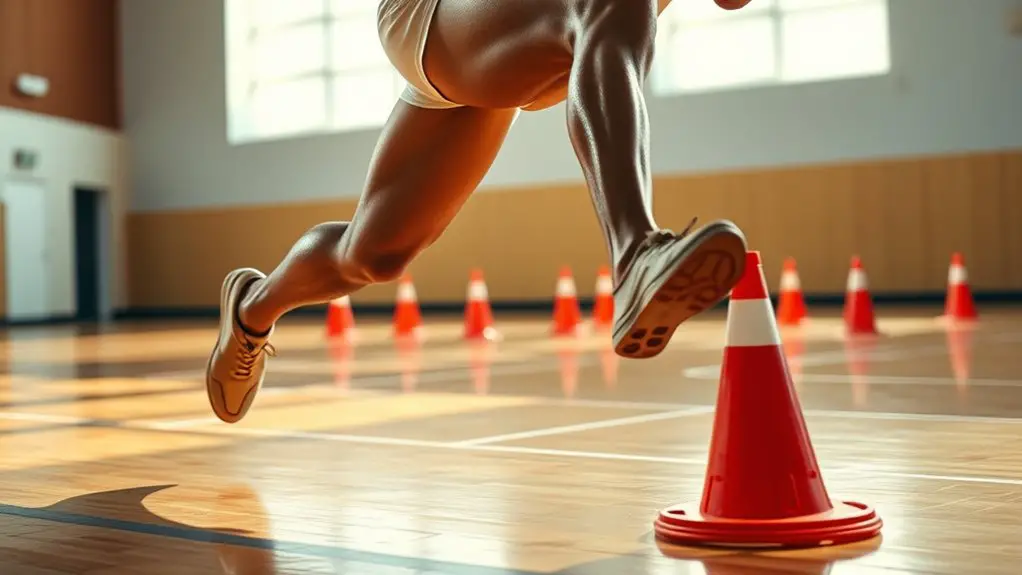Ankle strength is essential for enhancing your agility. Strong ankles offer a stable foundation for quick, precise movements, helping you pivot and change direction effectively. They also absorb shock, support balance, and prevent injuries like sprains and fractures, which can sideline you. By incorporating specific exercises into your routine, you can boost ankle strength and overall performance. Keep exploring to discover more ways to enhance your agility and athletic potential.
Understanding the Role of Ankles in Agility
While you might not realize it, your ankles play an essential role in agility training. They're not just joints; they're the foundation that enables quick, precise movements. Strong ankles help you pivot, jump, and change direction with ease, allowing you to move freely and confidently. When you engage in agility drills, your ankle strength and stability directly impact your performance.
Every sprint, sidestep, or leap relies on your ankles' ability to absorb shock and provide balance. They help you maintain control, preventing slips and falls that can hinder your progress. Plus, strong ankles enhance your overall body mechanics, making it easier to execute complex maneuvers without hesitation. Incorporating proper footwear into your training can further support ankle strength and stability.
Common Ankle Injuries in Athletes
Ankle injuries are all too common in athletes, and knowing the types can help you stay aware. Sprains and fractures are just a couple of the injuries that can sideline you. Understanding the risk factors involved can also play a vital role in preventing these setbacks. Recognizing the symptoms of ankle sprains can aid in early treatment and recovery.
Types of Ankle Injuries
Injuries to the ankle are some of the most common setbacks athletes face, often hindering performance and prolonging recovery times. Sprains are a frequent issue, usually occurring when the ligaments are stretched or torn due to awkward landings or sudden changes in direction. Fractures can happen as well, especially during high-impact activities, leading to severe pain and swelling. Tendon injuries, such as Achilles tendinitis, arise from overuse and can cause significant discomfort, impacting your ability to train effectively. Finally, conditions like ankle impingement can limit range of motion, making it tough to perform at your best. Understanding these injuries can help you take better care of your ankles, ensuring you stay agile and strong in your athletic pursuits.
Risk Factors for Injuries
Understanding risk factors for common ankle injuries can help you take proactive steps to protect yourself during training and competition. Factors like poor ankle strength, inadequate warm-ups, and improper footwear can increase your risk. If you're training on uneven surfaces or pushing your limits without proper conditioning, you might be setting yourself up for injury. Additionally, a history of previous ankle injuries can make you more susceptible to re-injury. Always pay attention to how your body feels; any signs of discomfort shouldn't be ignored. By focusing on building ankle stability and strength, and being mindful of your training environment, you can considerably reduce the chances of getting sidelined by an ankle injury and enjoy your athletic pursuits more freely.
Benefits of Strong Ankles for Performance
Strong ankles can greatly boost your performance by enhancing stability and balance, which are essential in any sport. You'll also notice improved explosive power, giving you an edge in quick movements and jumps. Investing in ankle strength isn't just about preventing injuries; it's about maximizing your athletic potential. Additionally, strong and flexible hamstrings contribute to fluid and powerful movement, further supporting agility and overall performance.
Enhanced Stability and Balance
When you engage in agility training, having robust ankle strength can greatly enhance your stability and balance. Strong ankles act as a solid foundation, allowing you to navigate sharp turns and sudden stops with confidence. This stability lets you move freely without the fear of losing your footing. You'll find that your body can maintain proper alignment during dynamic movements, reducing the risk of injury. With improved balance, you can effortlessly shift your weight and adjust to changing environments, making your training more effective. Ultimately, strong ankles enable you to explore your physical potential, giving you the freedom to push your limits without hesitation. Embrace the journey of enhancing your ankle strength and reveal greater stability in every stride.
Improved Explosive Power
Having solid ankle strength doesn't just improve stability and balance; it also contributes greatly to your explosive power during athletic activities. When you jump, sprint, or change direction, strong ankles act as a springboard, allowing for quicker and more powerful movements. This can elevate your performance in competitions and recreational sports alike.
Here's a quick overview of how ankle strength impacts explosive power:
| Aspect | Strong Ankles | Weak Ankles |
|---|---|---|
| Power Generation | High | Low |
| Speed of Movement | Fast | Slow |
| Injury Resistance | High | Low |
Key Exercises for Ankle Strengthening
Building resilient ankles is essential for enhancing overall agility and preventing injuries. You can strengthen your ankles with a few key exercises that fit seamlessly into your routine. These movements not only build stability but also empower your performance, giving you the freedom to move with confidence.
- Heel Raises: Stand on the edge of a step and lift your heels. This targets the calf muscles and improves ankle stability.
- Ankle Circles: Sit or stand and rotate your ankle in circular motions. This enhances mobility and coordination.
- Resistance Band Exercises: Use a resistance band to perform dorsiflexion and plantarflexion. This adds resistance to your movements, building strength and control.
Incorporating these exercises will set the foundation for strong, agile ankles, allowing you to move freely and confidently in any activity you choose. Additionally, proper warm-ups and stretching are crucial for prevention of injuries related to ankle instability.
Incorporating Ankle Training Into Your Routine
Integrating ankle training into your regular workout routine can greatly enhance your agility and overall performance. Start by dedicating just a few minutes each session to specific exercises. Try incorporating ankle circles and resistance band exercises to build strength and flexibility. You can also add balance challenges, such as standing on one leg or using a balance board, which will engage your stabilizing muscles.
Don't forget to include dynamic movements like lateral hops or jumping rope. These exercises not only boost ankle strength but also elevate your heart rate and improve coordination. Make it fun by mixing in agility drills or playing sports that require quick footwork. Additionally, effective footwork helps reduce the risk of sprains during intense activities, further emphasizing the importance of ankle strength in your training.
The Relationship Between Ankle Strength and Balance
As you work on improving your ankle strength, you'll likely notice a significant impact on your balance. Stronger ankles provide a solid foundation for your movements, allowing you to navigate various terrains and activities with ease. This newfound stability can empower you, giving you the freedom to move confidently and enjoy life's adventures.
Here are a few ways stronger ankles enhance your balance:
- Increased proprioception: You'll gain better awareness of your body's position, helping you adjust quickly when needed.
- Enhanced stability: Strong ankles support your body during dynamic movements, reducing the risk of falls or injuries.
- Improved agility: A solid balance translates into quicker, more controlled movements, whether you're running, jumping, or changing directions.
How Ankle Strength Affects Overall Stability
When you strengthen your ankles, you're not just improving one aspect of your body; you're enhancing your overall stability. Strong ankles provide a solid foundation, allowing you to move freely and confidently in any direction. This stability is essential for activities that demand quick changes in movement, whether you're playing sports or simply enjoying an active lifestyle.
With improved ankle strength, you'll notice better control and balance, reducing the risk of falls or awkward landings. It also allows your body to distribute weight more effectively, so you're less likely to overcompensate with other joints, which can lead to injuries. Incorporating flexibility and mobility work into your training routine further supports ankle health and enhances overall performance.
Tips for Preventing Ankle Injuries
To prevent ankle injuries, it's crucial to incorporate a few simple strategies into your routine. Strong, flexible ankles can give you the freedom to move without fear of injury, allowing you to fully enjoy your activities. Here are some tips to help keep your ankles safe:
Incorporating simple strategies can strengthen your ankles, allowing you to move freely and enjoy your activities without fear of injury.
- Warm Up Properly: Always take time to stretch and warm up your ankles before any intense activity. This prepares your muscles and joints for movement.
- Wear Supportive Footwear: Choose shoes that provide good support and cushioning. They can greatly reduce your risk of rolling or straining your ankle.
- Strengthen Your Ankles: Incorporate exercises that target your ankle strength and stability. Strong ankles can help you absorb shock and maintain balance during dynamic movements. Additionally, strengthening surrounding muscles can significantly reduce injury risk and enhance overall athletic performance.
Monitoring Progress in Ankle Strength Training
While strengthening your ankles can greatly reduce the risk of injuries, monitoring your progress in ankle strength training is just as important. Tracking your improvements helps you stay motivated and guarantees you're on the right path. Start by setting clear, achievable goals. Whether it's the number of repetitions, weight increases, or balance duration, having measurable targets gives you something to aim for.
Use a journal or an app to log your workouts and note your progress. Regularly assess your strength through exercises like single-leg stands or resistance bands. This'll help you identify areas needing more focus. Additionally, maintaining proper hydration levels is crucial for optimal muscle function during your training sessions.
Don't forget to listen to your body; if you feel pain, it's a sign to adjust your routine. Celebrate your achievements, no matter how small, as they're stepping stones toward stronger ankles. By monitoring your progress, you're empowering yourself to achieve ideal agility and freedom in movement.
Frequently Asked Questions
How Long Does It Take to See Improvements in Ankle Strength?
You might start noticing improvements in ankle strength within four to six weeks of consistent training. Stay committed, listen to your body, and you'll achieve greater freedom in your movements and activities. Enjoy the journey!
Can Ankle Strength Impact Performance in Non-Sport Activities?
Absolutely, ankle strength can affect your performance in daily activities. Stronger ankles provide better stability and balance, which helps you move freely and confidently, whether you're walking, climbing stairs, or engaging in recreational activities.
Are There Specific Diets to Support Ankle Strength Training?
You won't find a specific diet just for ankle strength, but a balanced intake of protein, healthy fats, and vitamins can support overall muscle health. Focus on whole foods to fuel your training effectively.
Should I Consult a Professional Before Starting Ankle Exercises?
It's often said that self-training is enough, but consulting a professional can provide tailored guidance, ensuring you avoid injuries and maximize results. You deserve the freedom to train effectively and safely, so consider expert advice.
What Are the Signs of Overtraining My Ankles?
If you're overtraining your ankles, you might notice persistent pain, swelling, or stiffness. Fatigue during workouts and decreased performance are also signs. Listen to your body; it knows when it needs rest and recovery.




